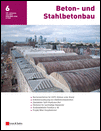
Beton- und Stahlbetonbau
Scope & Guideline
Advancing Concrete Engineering Knowledge
Introduction
Aims and Scopes
- Innovative Material Use:
The journal frequently explores the use of novel materials such as carbon-reinforced concrete, ultra-high-performance concrete (UHPC), and recycled aggregates, highlighting their mechanical properties and applications in construction. - Structural Engineering and Design:
Papers often address the design and analysis of concrete structures, including bridges, buildings, and other infrastructure, focusing on innovative design approaches and structural behavior under various loading conditions. - Sustainability and Environmental Impact:
A consistent emphasis is placed on sustainable construction practices, including life cycle assessments, resource efficiency, and the integration of eco-friendly materials and methods in concrete construction. - Advanced Testing and Monitoring Techniques:
The journal covers advancements in testing methods and monitoring technologies, such as the use of fiber optic sensors and non-destructive testing methods, to assess the condition and performance of concrete structures. - Construction Technology and Automation:
Research on the integration of digital technologies and automation in concrete production and construction processes is highlighted, showcasing innovative approaches to enhance efficiency and quality in construction.
Trending and Emerging
- Sustainable and Circular Construction:
An increasing number of papers are addressing sustainability, focusing on circular economy principles, recycling of concrete materials, and the use of environmentally friendly construction practices. - Digitalization and Smart Construction:
There is a growing trend towards the integration of digital technologies in construction, including the use of Building Information Modeling (BIM), digital twins, and automation in concrete production. - High-Performance and Specialty Concretes:
Research on high-performance concretes, including ultra-high-performance concrete (UHPC) and fiber-reinforced concrete, is gaining traction, showcasing their applications in demanding structural contexts. - Resilience and Adaptation to Climate Change:
Emerging themes include the resilience of concrete structures to climate change effects, focusing on durability, maintenance, and adaptation strategies for existing infrastructure. - Advanced Structural Monitoring Techniques:
The use of innovative monitoring technologies, such as remote sensing and fiber optic sensors, is becoming a prominent focus, enabling better assessment and management of concrete structures.
Declining or Waning
- Traditional Concrete Technologies:
There is a noticeable reduction in publications focused on conventional concrete technologies and methods, as the field increasingly shifts towards innovative and sustainable alternatives. - Non-Reinforced Concrete Applications:
Research on non-reinforced concrete applications has diminished, as the focus has moved towards reinforced and composite materials that offer enhanced structural performance. - Basic Theoretical Studies:
The journal has seen a decrease in papers dedicated to fundamental theoretical approaches in concrete mechanics, as practitioners and researchers prioritize applied research with direct implications for construction practices.
Similar Journals

Bridge Structures
Building Knowledge Bridges in Structural EngineeringBridge Structures is an esteemed academic journal dedicated to the field of structural engineering, particularly focusing on the design, analysis, and maintenance of bridge systems. Published by IOS PRESS, a reputable publisher known for its contributions to various scientific fields, the journal serves as an integral platform for disseminating innovative research and advancements within the domain. With an ISSN of 1573-2487 and an E-ISSN of 1744-8999, Bridge Structures has established itself over the years—covering contributions from 2005 to 2024. The journal has attained a commendable ranking within the Q3 category in Building and Construction and holds a position within the 28th percentile among its peers according to the Scopus rankings. Though the journal operates on a subscription basis, its commitment to advancing engineering knowledge is paramount, making it essential reading for researchers, practitioners, and students eager to deepen their understanding of bridge engineering. The journal not only explores theoretical advancements but also emphasizes practical applications, providing a well-rounded perspective on current challenges and solutions in the field of bridge structures.

Advances in Concrete Construction
Building Tomorrow's Structures TodayAdvances in Concrete Construction, published by TECHNO-PRESS in South Korea, is a pivotal academic journal dedicated to the fields of Building and Construction, Civil and Structural Engineering, and Mechanics of Materials. Established with the aim of fostering innovative research, this journal has rapidly gained recognition, achieving a commendable Q2 ranking across multiple categories, including Safety, Risk, Reliability, and Quality as of 2023. Featuring a blend of rigorous peer-reviewed articles, the journal serves as a vital platform for scholars, engineers, and students alike to disseminate cutting-edge research and practical applications in concrete construction technologies. Despite its absence of Open Access, the journal's inclusion in Scopus with notable rankings - such as #66 in Building and Construction - underscores its growing influence and commitment to quality as it converges on significant advancements from 2016 to 2024. By contributing to this respected journal, you join a community dedicated to exploring the future of sustainable and efficient construction practices.
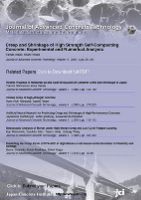
Journal of Advanced Concrete Technology
Connecting Ideas in Concrete InnovationThe Journal of Advanced Concrete Technology, published by the JAPAN CONCRETE INST, is a leading academic journal dedicated to the specialized field of concrete technology, offering invaluable insights and research findings that push the boundaries of knowledge in construction materials and engineering. With an ISSN of 1346-8014 and an E-ISSN of 1347-3913, this journal has been an influential platform since its inception in 2003, converging its focus through to 2024. The journal holds a commendable position within the Q2 category in both Building and Construction and Materials Science for 2023 and ranks in the 63rd and 47th percentiles, respectively, reflecting its significant contribution to these disciplines. Accessible only through traditional subscription models, it is a critical resource for researchers, professionals, and students looking to explore contemporary advancements in concrete applications and innovations. Engaging with this journal not only enables a deeper understanding of materials science but also fosters collaboration and dialogue within the global engineering community, making it an essential read for anyone invested in the future of construction technology.

Cement Wapno Beton
Advancing the Future of Construction ScienceCement Wapno Beton is a renowned academic journal published by STOWARZYSZENIE PRODUCENTOW CEMENTU, focusing on the intricate fields of building and construction, as well as materials science. With the ISSN number 1425-8129, this publication has been committed to advancing knowledge and fostering innovation since its inception in 2007, and it will continue until 2024. The journal operates within a competitive landscape, as reflected in its 2023 Scopus rankings, placing it in the third quartile (Q3) in both Building and Construction and Materials Science categories. Although it currently does not offer open access options, Cement Wapno Beton remains an essential resource for researchers, professionals, and students seeking valuable insights into the latest developments and technologies in construction materials. Its scope encompasses a wide range of topics, including architectural advancements, sustainable building practices, and innovative material applications, making it an indispensable tool for those dedicated to the evolution of construction science.
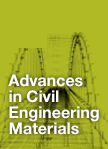
Advances in Civil Engineering Materials
Unveiling the Next Generation of Construction MaterialsAdvances in Civil Engineering Materials, published by the American Society for Testing and Materials, is a leading journal in the field of civil engineering, specializing in the innovative applications and developments of materials used in construction and infrastructure. With an ISSN of 2379-1357 and an impressive lineup of contributions from renowned researchers, this journal serves as a pivotal platform for disseminating groundbreaking research from 2012 to 2024, currently enjoying a category quartile ranking of Q2 across multiple disciplines including Ceramics and Composites, Civil and Structural Engineering, and Materials Chemistry. Though it operates under a subscription model, the valuable insights and advancements presented in the journal have a significant impact on both academia and industry practices. Researchers, professionals, and students are invited to explore the evolving landscape of civil engineering materials, gaining critical knowledge to drive innovations and contribute to the sustainability and safety of architectural endeavors.
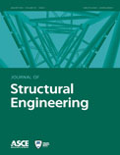
JOURNAL OF STRUCTURAL ENGINEERING
Defining the Landscape of Structural EngineeringThe JOURNAL OF STRUCTURAL ENGINEERING, published by the ASCE-AMERICAN SOCIETY OF CIVIL ENGINEERS, is a premier academic journal that focuses on the latest advancements in the field of structural engineering. With a rich history dating back to 1955, this journal has become a crucial platform for disseminating peer-reviewed research that addresses critical issues and innovative solutions in building and construction, civil and structural engineering, materials science, and mechanics. It proudly holds a Q1 quartile ranking across multiple categories in the 2023 Scopus rankings, indicating its influential presence in the academic community. The journal does not currently offer open access options, ensuring that the content is rigorously vetted for quality and relevance, thus appealing to researchers, industry professionals, and students seeking credible, impactful research. With contributions from leading experts, the JOURNAL OF STRUCTURAL ENGINEERING is essential reading for anyone interested in advancing their understanding and practice within this vital area of engineering.
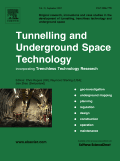
TUNNELLING AND UNDERGROUND SPACE TECHNOLOGY
Advancing Geotechnical Engineering for Tomorrow's Challenges.TUNNELLING AND UNDERGROUND SPACE TECHNOLOGY, published by Pergamon-Elsevier Science Ltd, stands at the forefront of research in the fields of tunnelling, underground construction, and geotechnical engineering. With the high reputation reflected in its prestigious Q1 status in both Building and Construction and Geotechnical Engineering and Engineering Geology quartiles, this journal serves as an essential platform for pioneering studies and innovative practices. The journal has demonstrated a notable impact in the academic community, evidenced by its impressive Scopus rankings, with an esteemed rank of #7 in Geotechnical Engineering out of 229 journals, placing it in the 97th percentile. This positions it as a vital resource for researchers and professionals seeking the latest advancements in underground space technology. Published since 1986 and continuing through 2024, the journal aims to disseminate cutting-edge research that enhances both the science and practice of tunnelling, providing a significant repository for students and experts eager to advance their understanding and expertise in this critical area of engineering.
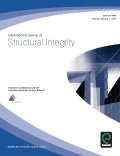
International Journal of Structural Integrity
Driving Innovation in Mechanics of MaterialsInternational Journal of Structural Integrity is a premier peer-reviewed academic journal published by EMERALD GROUP PUBLISHING LTD in the United Kingdom. As a valuable resource in the fields of Civil and Structural Engineering, Mechanical Engineering, and Mechanics of Materials, this journal serves to advance knowledge and foster innovation in these critical areas of study. With an impressive impact factor reflected in its 2023 category quartiles, ranking Q2 across multiple engineering disciplines, the journal is recognized for its contributions to research and practical application. Researchers can benefit from its rigorous publishing standards that encompass a wide array of interdisciplinary topics pertaining to structural integrity. Accessing the journal is facilitated for those seeking high-quality research and findings, vital to both academia and industry. Since its inception in 2010 and extending until 2024, the journal continues to attract scholarly articles that push the boundaries of engineering knowledge, making it an essential platform for professionals, students, and researchers seeking to stay at the forefront of structural engineering."

R Journal
Fostering Excellence in Statistical MethodologiesR Journal, published by the R Foundation for Statistical Computing, is a premier academic journal dedicated to advancing the fields of numerical analysis and statistical methodologies. With an ISSN of 2073-4859, the journal has established itself as a significant platform for high-quality research since its inception in 2009. It operates under a Q2 category ranking in respective fields, including Statistics and Probability, among others, highlighting its influence and relevance in the academic community. Researchers are encouraged to contribute their findings, as the journal appeals broadly to statisticians, mathematicians, and data scientists alike. Although not an open-access journal, its commitment to rigorous peer review ensures that published works maintain high standards of scientific integrity. The R Journal's vision is to foster innovative approaches within statistical computing, making it an invaluable resource for those seeking to deepen their understanding or stay abreast of developments in the discipline.

ACI MATERIALS JOURNAL
Connecting Theory and Practice in Concrete InnovationWelcome to the ACI Materials Journal, a premier publication in the field of materials science and engineering, published by the American Concrete Institute. Since its inception in 1987, this journal has continually contributed to advancing the understanding of concrete materials and structures, playing a vital role in both academic and practical applications. With an impressive impact factor and consistently ranking in the Q1 category for Building and Construction and Civil and Structural Engineering, the ACI Materials Journal is recognized for its rigorous peer-review process and high-quality research contributions. It serves as a crucial platform for researchers, practitioners, and students, featuring articles that explore innovative materials, sustainable practices, and cutting-edge technology, all of which are essential for the future of the civil engineering domain. Although the journal is not open access, it remains accessible to a vast audience through institutional subscriptions.